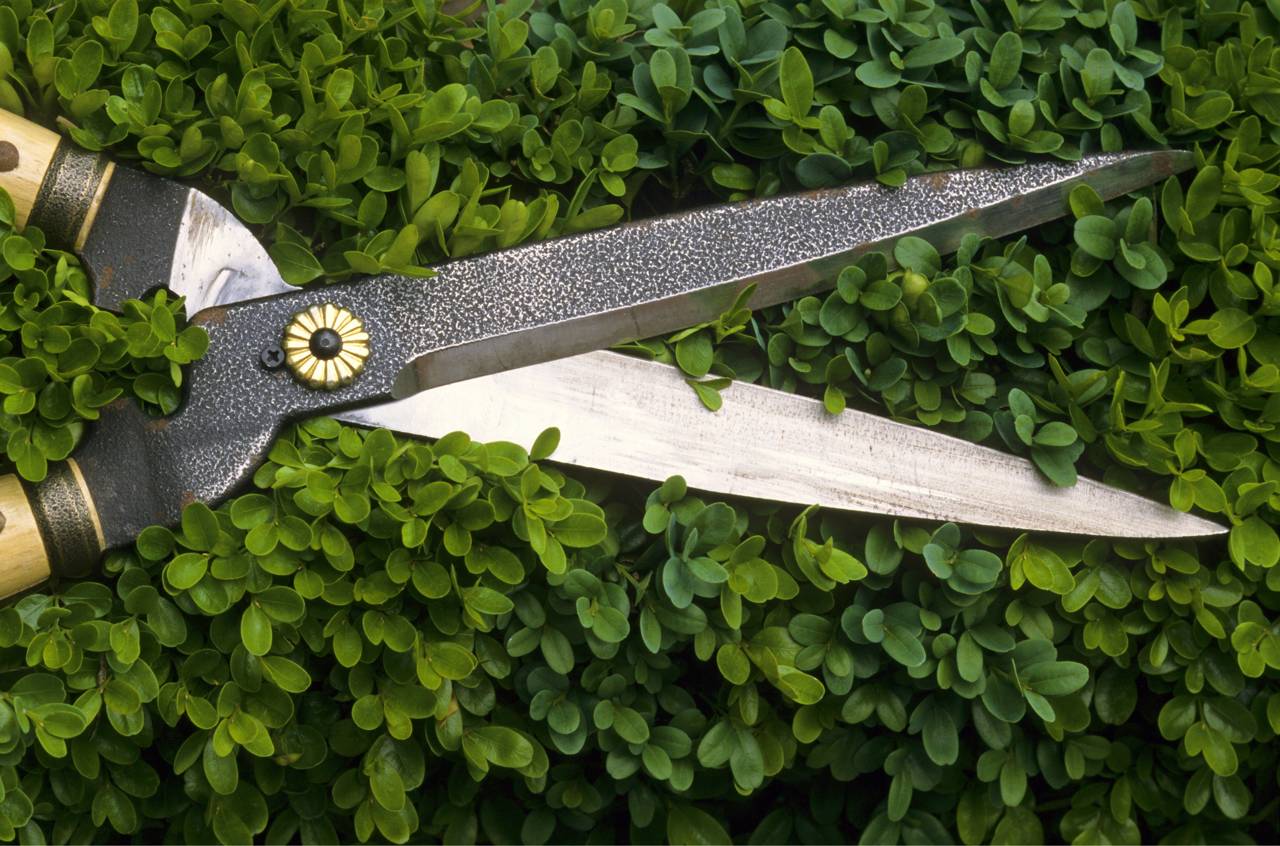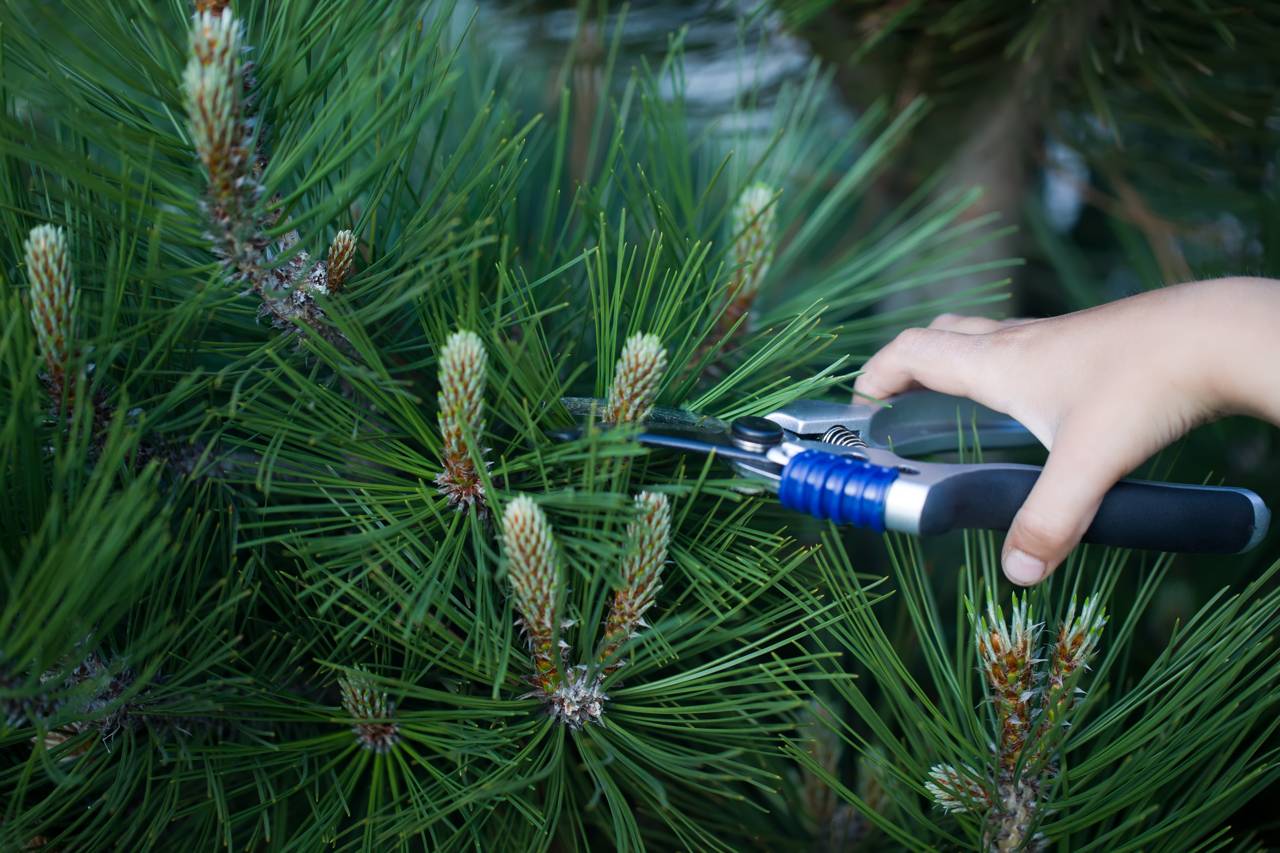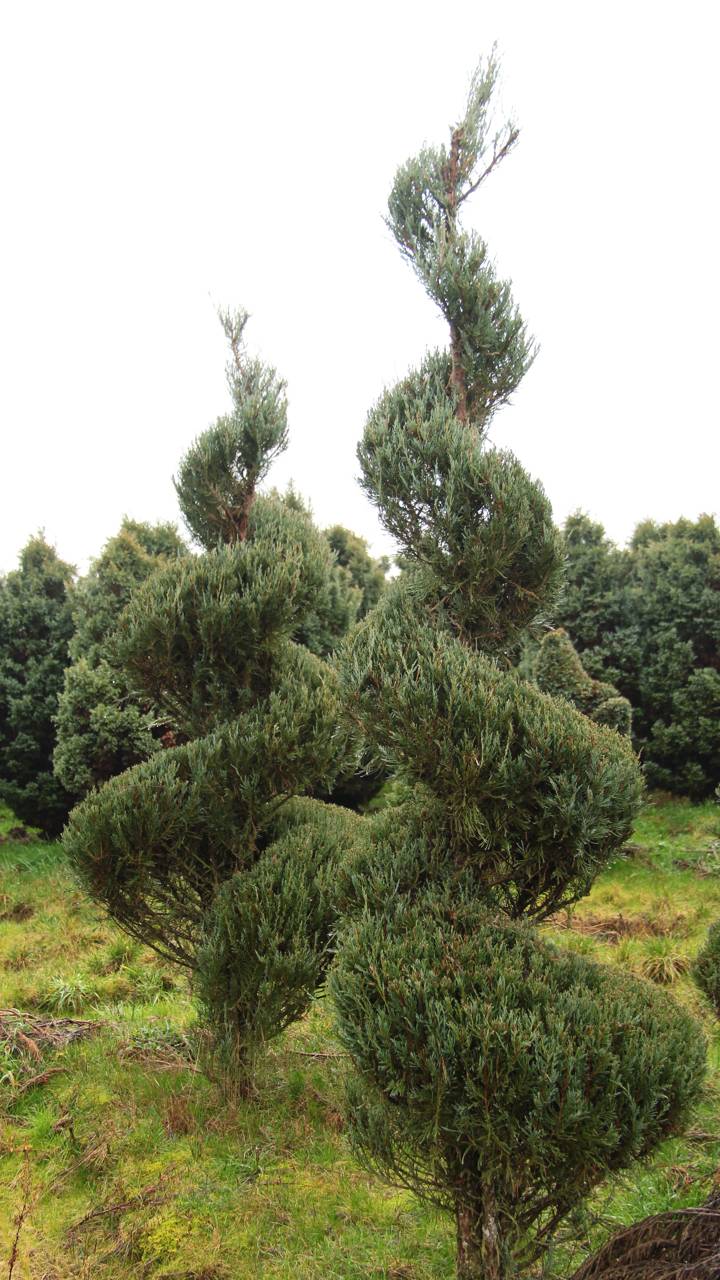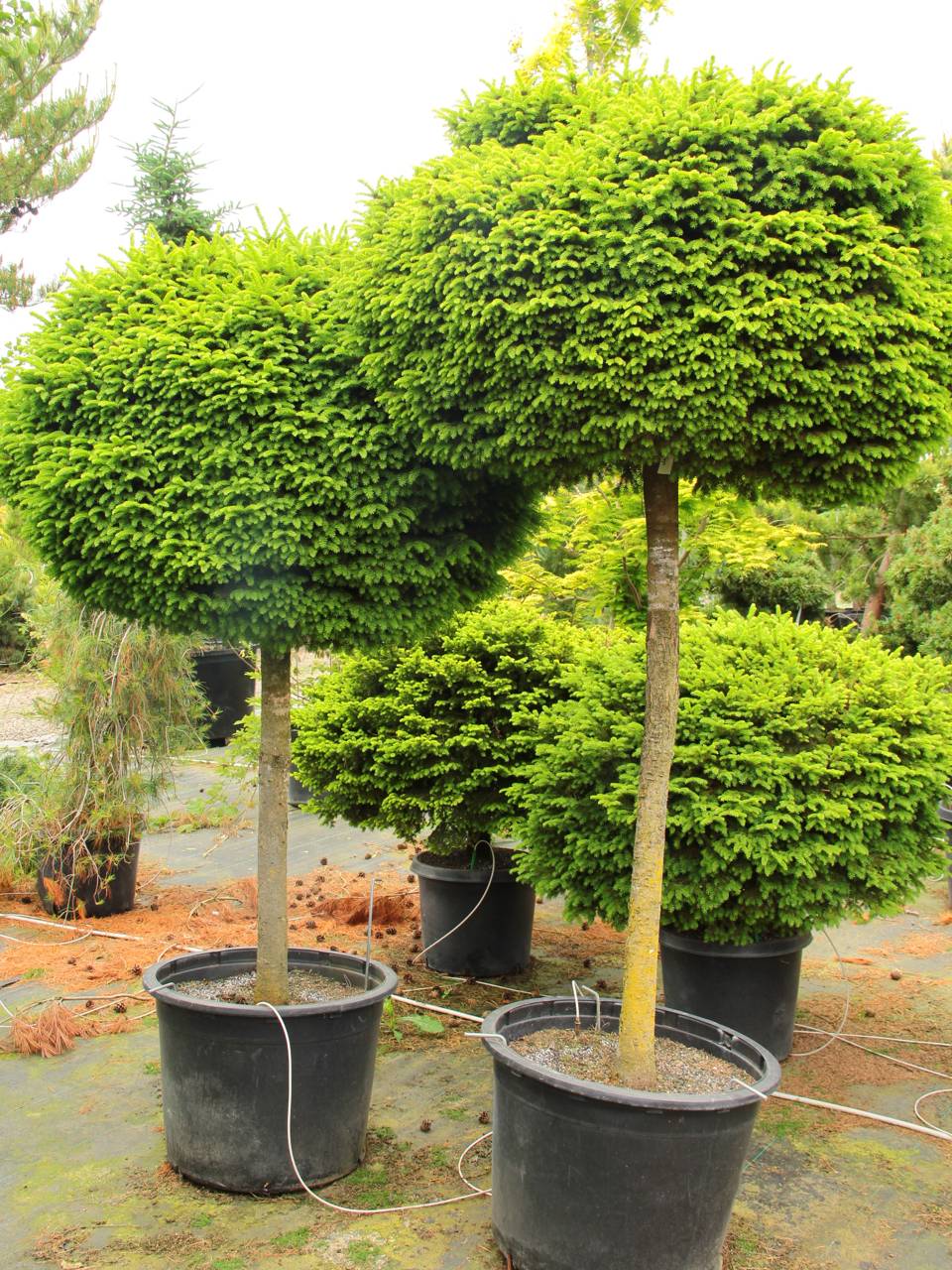How to Prune Conifers
Well-maintained evergreens provide year-round structure to a landscape. Although conifers are considered a low-maintenance plant, they’re picky about the pruning process.
Dwarf conifers are an excellent landscape plant because they require far less pruning to keep them a manageable shape and size near homes or in planters.
Conifers should be pruned sparingly or else they may develop dead spots. There are three reasons to prune a conifer:
- To remove dead/diseased wood
- To control size
- To control shape
The most common mistake in landscaping is to plant the wrong plant in the wrong place, which can lead to a lot of unnecessary pruning. If you plant a large tree in a small space, the plant will suffer and you will struggle to contain new growth. Follow the right plant, right place rule to minimize pruning time in the future.
Ready to begin?

Buxus boxwood pruning
Good, put those hedge trimmers down and learn the art of pruning conifers.
Conifer Pruning Tools
First, let’s start with what you don’t need: hedge trimmers.
Although they may be the easiest, fastest way to give your hedges a flat-top, they don’t work well with a conifer’s growth pattern.
Needled evergreens can only heal and regrow from buds within the first few inches of a branch.
Clean, properly-placed cuts will remove enough plant material to stimulate new growth without going too far and debilitating the entire branch.
Hedge trimmers rip and tear through branches to create an even shape, but they can leave open wounds that have trouble healing, and it’s easy to cut too deep and cause permanent damage.
Although hedge trimmers have their place among professional landscapers, it’s better to learn how conifers grow and which tools to use to make small, precise cuts to create healthy, mature plants.
Common Pruning Tools
The key to clean, sharp cuts is clean, high-quality tools.
Dip tools in a 10% bleach solution after each cut, and clean blades with mild soap and water after each pruning session. This will prevent transferring diseases from branch to branch, as well as prevent rust in storage.
To make a complete pruning set, you will need the following:
-
Bypass pruners
- For most dwarf conifers, a high-quality set of bypass pruners will be sufficient for maintaining the shape and size of a shrub or small tree. Use bypass pruners on branches 1” in diameter or smaller.
-
Bypass pruners
- For most dwarf conifers, a high-quality set of bypass pruners will be sufficient for maintaining the shape and size of a shrub or small tree. Use bypass pruners on branches 1” in diameter or smaller.
-
Snips
- Snips are precision tools that help create clean shapes. They are also helpful on smaller conifers and tender, young growth.
-
Loppers
- Loppers are used for cutting off branches or pruning back dead and diseased wood. Use loppers on branches 2” in diameter or smaller.
-
Pruning saw
- Pruning saws are for cutting branches 2” in diameter or thicker. If you are using a pruning saw, you should also use the pruning method known as the safety cut.
-
Hand shears
- Hand shears help with trimming small amounts of growth off hedges or shaped plants. Hand shears aren’t as precise as pruners or snips, but they have a much cleaner cut than hedge trimmers.
Keep your pruning tools clean, dry, and sharp to extend the life of the blades.
When to Prune Conifers
Timing is important when you prune conifers.
You can begin pruning conifers the day you plant them. Always remove dead or diseased wood before you plant, and prune long, scraggly branches. This way, the plant won’t waste energy supporting undesirable plant material while it is trying to build a new root system.
Avoid harsh pruning until the plant has recovered from transplanting and shows signs of new growth.
Many conifers are only able to trigger new growth from dormant buds during a small window of time. If you prune during this window, the plant will recover and heal while sprouting new lateral branches and becoming fuller.
If you prune outside this window, the plant may be able to heal from the cut, but it won’t be able to fill in the pruned area, which can leave an open space or brown spot in the outer foliage.
The only time you should prune outside the normal window is if there are broken, diseased, or dead branches.
Prune pines in the spring when they are producing candles, or new growth from the tips of the branches. Pines have a beautiful natural shape and they don’t respond well to heavy shaping. Limit pruning to removing diseased or damaged wood and candling in the spring for more full branches.
Prune spruce , firs , and Douglas firs in later winter before new spring growth. These conifers have a more compact, dense growth pattern and may need to maintain a certain size or shape, which is easier to direct if you prune before the spring growth spurt.
Prune junipers , cypress ,redwoods , and yews any time throughout the year, as long as the weather is mild. These conifers are always growing, so they can tolerate consistent pruning and shaping. These plants are best for formal or sharp hedges and shaping.
Always prune early in the day to give wounds a chance to scab over before the sun goes down. This will help prevent diseases or infections.
Avoid pruning during extremely hot, cold, windy, or wet weather conditions. Heavy pruning during extreme weather will cause excess stress and may harm the overall health of the plant.
How to Remove Dead/Diseased Wood from Conifers
Any time a plant has dead, dying, or broken branches, prune them off as soon as possible. This damage may spread to healthy tissue, and it might permanently alter the shape of the tree or shrub if you don’t take it out with a clean cut.
There are many causes of dead or dying branches:
- Heavy snowfall/ice
- Salt spray
- Vehicle damage
- Mold/rot/disease
- Old, dead wood
- Pest damage
Pest damage
If the damage is light, and it only affects the first few inches of green growth, you can prune off the damage the same way you would shape new growth. However, most damage on conifers reaches far into the middle of the plant, so this is uncommon.
If the damage reaches beyond the first few inches of growth, you should take a step back and look at the big picture. Odds are, the branch will be a stub if you prune off a moderate portion of damage.
In most cases, the easiest and most straightforward way to prune off dead, damaged wood is to prune the branch back to the trunk. However, you may be able to save a portion of the branch if you prune back to a healthy fork in the damaged wood.
Dead, lower branches or inner branches can be pruned off. Cut these back to the swollen joint near the trunk.
Use loppers or a hand saw to prune off full branches.
If the branch is 2” in diameter or less, use loppers. Make a clean, angled cut above the swollen joint where the branch meets the trunk (or the other branch).
For extremely large branches, remove portions of the branch as you work back towards the final cut. This reduces the weight on the loppers as they cut, and it makes the final cut more even.
If the branch is over 2” in diameter, use a hand saw. Make an angled cut above the swollen area where the branch joins the trunk. Make long, smooth cuts to give the wound clean edges.
For long or heavy branches, make a safety cut. This technique consists of three separate cuts.
The first cut removes excess weight, which makes it easier to make the second and third cuts.
The second cut is a precautionary measure in case the branch breaks during the final cut. If the branch snaps or breaks, the bark can rip or break pieces of the trunk. The precautionary cut acts as a stopgap to mitigate potential damage.
The final cut is the removal of the stub from the trunk. This cut should be clean to aid healing.
To make a safety cut:
- Lop off the majority of the branch with loppers to remove excess weight
- Make a cut 1” deep from underneath the branch near the final cut
- Cut off the branch with an angled cut above the swollen joint where the branch meets the trunk
Use a safety cut when you remove long, heavy lower branches from pines. Safety cuts prevent ripping or tearing in case the branch breaks away from the trunk while you are sawing.
If your tree has a double leader, prune away the weaker branch.
A leader is the branch that extends straight up at the top of a plant and is responsible for upward growth. Some plants have double leaders, which can lead to a fork in the trunk and weaken the tree.
Cut off the weaker leader down to where it meets the trunk.
Do not damage the primary leader. If you cut off both leaders, you will top your tree, which may permanently stunt the growth. Sometimes, gardeners do this on purpose if trees are going to come into contact with power lines, but it leaves an ugly, flat-topped plant that could have been avoided with proper planning.
How to Prune to Control the Size of Conifers
This is more complicated than removing dead or dying wood. When you prune to maintain size, you must be consistent and thorough with a clear image in mind.
Dwarf conifers grow slowly, and most of them will remain small throughout their lifetime. However, you may want to keep a plant within certain visual or physical boundaries, which is where candling and tip pruning come into practice.
Candling is a method used to control the overall size of pine trees.

Candle Pruning
In the spring, pines put out new, green growth known as candles. These candles add to the overall size and shape of the plant.
If they are left untouched, the plant will reach its mature size. If you pinch off some or all of the annual growth, the plant will stay the same size.
If you want to slow down the growth of a pine tree, use snips or bypass pruners during the spring to cut off half of the fresh growth. Wait until the candles are a few inches long before you prune.
If you want to completely halt the growth of a pine tree, use snips or bypass pruners to cut off all of the fresh growth during the spring.
Either way, make a neat, angled cut on the branch right above a bud. This will trigger small, lateral sprouts that will make the pine appear fuller and direct the overall shape.
Use a similar technique for spruce, fir, and Douglas fir, except begin the process before the burst of new growth in the spring.
Snip back the outer few inches by making an angled cut above a dormant bud. Never cut more than half of the green growth off any one branch.
Junipers, cypress, redwoods, and yews can be pruned more like deciduous plants.
Control the size of these plants by pruning off branches either where they join to other branches or where they meet the trunk.
Make an angled cut with pruners, loppers, or a hand saw, depending on the size. Cut above the swollen portion where the branch meets the main branch/trunk.
Use a safety cut for large branches.
How to Prune to Control the Shape of Conifers
The techniques to control shape are similar to the techniques to control size, except they are more detailed and severe.
There are many different ways to shape a conifer:
- Hedges
- Cones
- Clouds
- Globes
- Boxes
- Spirals
- Espalier

Juniperus scopulorum ‘Skyrocket’ spiral
Shaping has become an art form, but basic shaping can also be practical. For instance, you may need to keep new growth away from a building or power line.
Whether your shaping is for aesthetic or practical reasons, it’s important to have a goal early in the plant’s life so you can take small, consistent steps toward a desired shape.
The best conifers for artistic shapes are:
- Yews
- Junipers
- Alberta spruce
- Arborvitae
- Pines (cloud pruning)

Specimen 1500 Picea abies ‘Little Gem’ 4′ std.
These plants can withstand consistent pruning and maintain a strong shape, although yews are by far the most common plants for formal topiaries.
Formal shaping is an extensive topic, and it requires thorough planning and experience. However, you can create and maintain basic shapes with a few simple techniques.
First, have a plan. Don’t start shaping anything until you know what you want the mature plant to look like. Whether you’re planting a hedge or creating spiraled spruces, you must have a plan for the final shape and stick to it.
Second, take small steps. You can start pruning your dwarf conifers the day you transplant them. Take small, consistent steps to direct new growth in a direction that fills in the desired shape. Large cuts will look messy and won’t fill in properly.
Third, be consistent. Not only do you need to be consistent in the frequency of your pruning, but also in the desired shape. Changing direction after a few years will be extremely difficult unless you want a more loose, natural look.
For more practical shaping, like pruning around objects or walls, try to look ahead at what parts of the plant may become problematic in the future and remove them when they’re young. This will give the plant time to recover and be much less stressful than lopping off large, mature branches later in life.
Use bypass pruners or snips to shape conifers.
- Stand back from the plant and envision an outline for the desired shape.
- Start snipping and pruning small amounts of plant material into a rough outline. Remember: it’s always better to prune too little than too much.
- Take another step back and make note of which parts of the plant should be cut back further.
- Continue to prune and snip until you have a solid outline, taking a few breaks to step back and look at the big picture.
- Once you have a basic shape, let the plant recover. This is especially important for plants under 3 years old that are still establishing a root system.
As the plant grows, snip away new branches and stragglers to maintain the basic shape. Continue to do this a few times per year for basic shapes, like globes, cones, and hedges.
For more elaborate shapes, you will have to prune more often.
Spirals, clouds, and espalier pruning will require more consistent and detailed pruning.
When you make cuts, try to cut above a bud that will produce growth in the desired direction.
For example, if you prune back to a bud on the top of a branch, the new growth will point up, which may or may not work with the overall shape of the plant.
Take care to prune back to buds that will force the plant to grow into the desired shape. This will cut back on how often you need to prune, and it will also prevent undue stress from cutting off large portions of plant material in the future.
Dwarf conifers are an ideal choice for most hedges and shaped landscape plants because they grow slowly and have a small mature size. This eliminates the need for harsh pruning, and it allows you to focus on the artistic or aesthetic look these plants can provide to your landscape.
Find dwarf conifers for hedges and shaping here.